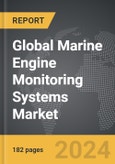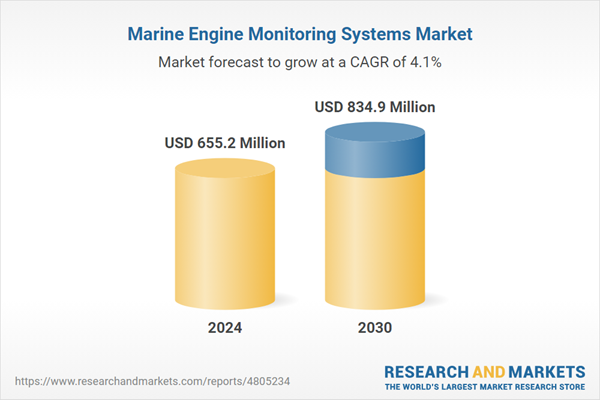The global market for Marine Engine Monitoring Systems was valued at US$655.2 Million in 2024 and is projected to reach US$834.9 Million by 2030, growing at a CAGR of 4.1% from 2024 to 2030. This comprehensive report provides an in-depth analysis of market trends, drivers, and forecasts, helping you make informed business decisions. The report includes the most recent global tariff developments and how they impact the Marine Engine Monitoring Systems market.
Segments: Engine Type (Propulsion, Auxiliary); Deployment (On-Board, Remote Monitoring); Ship Type (Commercial, Naval).
Geographic Regions/Countries: World; United States; Canada; Japan; China; Europe (France; Germany; Italy; United Kingdom; Spain; Russia; and Rest of Europe); Asia-Pacific (Australia; India; South Korea; and Rest of Asia-Pacific); Latin America (Argentina; Brazil; Mexico; and Rest of Latin America); Middle East (Iran; Israel; Saudi Arabia; United Arab Emirates; and Rest of Middle East); and Africa.
The analysts continuously track trade developments worldwide, drawing insights from leading global economists and over 200 industry and policy institutions, including think tanks, trade organizations, and national economic advisory bodies. This intelligence is integrated into forecasting models to provide timely, data-driven analysis of emerging risks and opportunities.
Global Marine Engine Monitoring Systems Market - Key Trends & Drivers Summarized
What Are Marine Engine Monitoring Systems and How Do They Enhance Vessel Performance?
Marine engine monitoring systems are crucial technologies designed to provide real-time data on the health and performance of marine engines. These systems monitor various parameters such as temperature, pressure, fuel consumption, and emissions, enabling operators to make informed decisions that enhance efficiency and prevent potential engine failures. With the increasing complexity of modern marine engines, these monitoring systems have become indispensable for maintaining optimal performance, reducing operational costs, and ensuring compliance with stringent environmental regulations. By offering continuous insights into engine conditions, marine engine monitoring systems help prevent costly downtime and extend the lifespan of marine vessels, making them a vital component of the maritime industry.How Are Technological Advancements Improving Marine Engine Monitoring Systems?
Technological advancements are significantly transforming marine engine monitoring systems, making them more efficient and reliable. The integration of Internet of Things (IoT) devices and cloud computing has revolutionized how data is collected and processed, allowing operators to monitor engines remotely and in real time. Advanced sensors, AI, and machine learning algorithms are enabling predictive maintenance, which identifies potential issues before they cause engine failure, reducing downtime and repair costs. Furthermore, modern monitoring systems can track fuel efficiency and emissions, helping operators comply with increasingly stringent environmental standards, such as the IMO 2020 sulfur cap. These technological innovations not only improve engine performance but also enhance the overall safety and sustainability of marine operations.What Challenges Are Associated with Implementing Marine Engine Monitoring Systems?
Despite their advantages, implementing marine engine monitoring systems presents several challenges. One of the key issues is the integration of these systems with existing, often outdated, engine infrastructure, which can be complex and costly. In addition, the sheer volume of data generated by these monitoring systems can be overwhelming for operators, requiring specialized software and personnel to manage and analyze the information effectively. Another challenge is ensuring the security of data, especially as IoT-enabled systems become more prevalent, raising concerns about potential cyberattacks. Moreover, the maritime industry often faces resistance to adopting new technologies due to the high costs and training required, further slowing down the implementation of these advanced monitoring systems.Growth in the Marine Engine Monitoring Systems Market Is Driven by Several Factors
The growth in the marine engine monitoring systems market is driven by several factors, including the increasing demand for operational efficiency, advancements in predictive maintenance technology, and rising environmental regulations. As shipping companies strive to reduce fuel costs and improve engine performance, the adoption of monitoring systems is becoming essential. Technological innovations in real-time monitoring, IoT, and AI-driven analytics are further fueling demand, as they enable more precise and proactive management of engine health. Additionally, regulatory pressures related to emissions and sustainability are prompting maritime operators to adopt systems that help them monitor and control engine output. These factors, along with the need to minimize downtime and maximize vessel longevity, are driving significant growth in the marine engine monitoring systems market.Report Scope
The report analyzes the Marine Engine Monitoring Systems market, presented in terms of units. The analysis covers the key segments and geographic regions outlined below.Segments: Engine Type (Propulsion, Auxiliary); Deployment (On-Board, Remote Monitoring); Ship Type (Commercial, Naval).
Geographic Regions/Countries: World; United States; Canada; Japan; China; Europe (France; Germany; Italy; United Kingdom; Spain; Russia; and Rest of Europe); Asia-Pacific (Australia; India; South Korea; and Rest of Asia-Pacific); Latin America (Argentina; Brazil; Mexico; and Rest of Latin America); Middle East (Iran; Israel; Saudi Arabia; United Arab Emirates; and Rest of Middle East); and Africa.
Key Insights:
- Market Growth: Understand the significant growth trajectory of the Propulsion segment, which is expected to reach US$519.7 Million by 2030 with a CAGR of a 4.0%. The Auxiliary segment is also set to grow at 4.4% CAGR over the analysis period.
- Regional Analysis: Gain insights into the U.S. market, valued at $172.5 Million in 2024, and China, forecasted to grow at an impressive 6.3% CAGR to reach $176.3 Million by 2030. Discover growth trends in other key regions, including Japan, Canada, Germany, and the Asia-Pacific.
Why You Should Buy This Report:
- Detailed Market Analysis: Access a thorough analysis of the Global Marine Engine Monitoring Systems Market, covering all major geographic regions and market segments.
- Competitive Insights: Get an overview of the competitive landscape, including the market presence of major players across different geographies.
- Future Trends and Drivers: Understand the key trends and drivers shaping the future of the Global Marine Engine Monitoring Systems Market.
- Actionable Insights: Benefit from actionable insights that can help you identify new revenue opportunities and make strategic business decisions.
Key Questions Answered:
- How is the Global Marine Engine Monitoring Systems Market expected to evolve by 2030?
- What are the main drivers and restraints affecting the market?
- Which market segments will grow the most over the forecast period?
- How will market shares for different regions and segments change by 2030?
- Who are the leading players in the market, and what are their prospects?
Report Features:
- Comprehensive Market Data: Independent analysis of annual sales and market forecasts in US$ Million from 2024 to 2030.
- In-Depth Regional Analysis: Detailed insights into key markets, including the U.S., China, Japan, Canada, Europe, Asia-Pacific, Latin America, Middle East, and Africa.
- Company Profiles: Coverage of players such as ASL Marine Holdings Ltd., China Deyuan Marine Fitting Co., Ltd., Echandia, Eneria, GRT Avionics and more.
- Complimentary Updates: Receive free report updates for one year to keep you informed of the latest market developments.
Some of the 14 companies featured in this Marine Engine Monitoring Systems market report include:
- ASL Marine Holdings Ltd.
- China Deyuan Marine Fitting Co., Ltd.
- Echandia
- Eneria
- GRT Avionics
- ITarian LLC
- Japan Marine (S) Pte. Limited
- Jason Marine Group
- Kistler Group
- Korindo Energy
Tariff Impact Analysis: Key Insights for 2025
Global tariff negotiations across 180+ countries are reshaping supply chains, costs, and competitiveness. This report reflects the latest developments as of April 2025 and incorporates forward-looking insights into the market outlook.The analysts continuously track trade developments worldwide, drawing insights from leading global economists and over 200 industry and policy institutions, including think tanks, trade organizations, and national economic advisory bodies. This intelligence is integrated into forecasting models to provide timely, data-driven analysis of emerging risks and opportunities.
What’s Included in This Edition:
- Tariff-adjusted market forecasts by region and segment
- Analysis of cost and supply chain implications by sourcing and trade exposure
- Strategic insights into geographic shifts
Buyers receive a free July 2025 update with:
- Finalized tariff impacts and new trade agreement effects
- Updated projections reflecting global sourcing and cost shifts
- Expanded country-specific coverage across the industry
Table of Contents
I. METHODOLOGYII. EXECUTIVE SUMMARY2. FOCUS ON SELECT PLAYERSIII. MARKET ANALYSISCANADAITALYSPAINRUSSIAREST OF EUROPESOUTH KOREAREST OF ASIA-PACIFICARGENTINABRAZILMEXICOREST OF LATIN AMERICAIRANISRAELSAUDI ARABIAUNITED ARAB EMIRATESREST OF MIDDLE EASTIV. COMPETITION
1. MARKET OVERVIEW
3. MARKET TRENDS & DRIVERS
4. GLOBAL MARKET PERSPECTIVE
UNITED STATES
JAPAN
CHINA
EUROPE
FRANCE
GERMANY
UNITED KINGDOM
ASIA-PACIFIC
AUSTRALIA
INDIA
LATIN AMERICA
MIDDLE EAST
AFRICA
Companies Mentioned (Partial List)
A selection of companies mentioned in this report includes, but is not limited to:
- ASL Marine Holdings Ltd.
- China Deyuan Marine Fitting Co., Ltd.
- Echandia
- Eneria
- GRT Avionics
- ITarian LLC
- Japan Marine (S) Pte. Limited
- Jason Marine Group
- Kistler Group
- Korindo Energy
Table Information
| Report Attribute | Details |
|---|---|
| No. of Pages | 182 |
| Published | April 2025 |
| Forecast Period | 2024 - 2030 |
| Estimated Market Value ( USD | $ 655.2 Million |
| Forecasted Market Value ( USD | $ 834.9 Million |
| Compound Annual Growth Rate | 4.1% |
| Regions Covered | Global |









